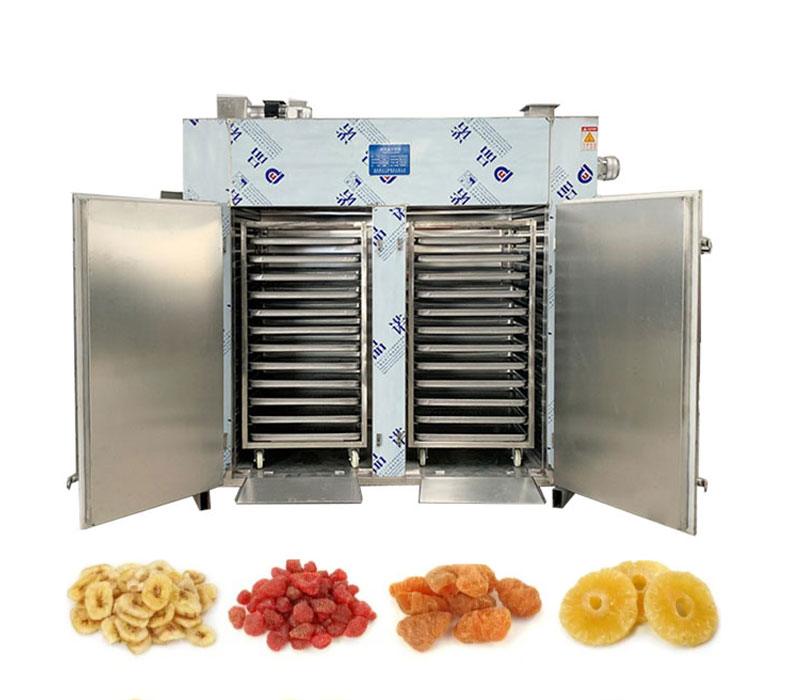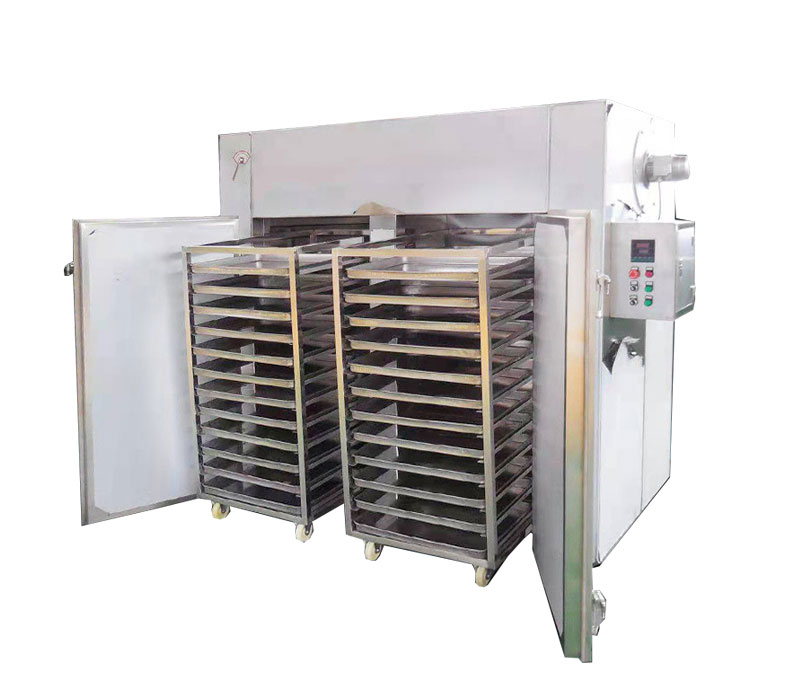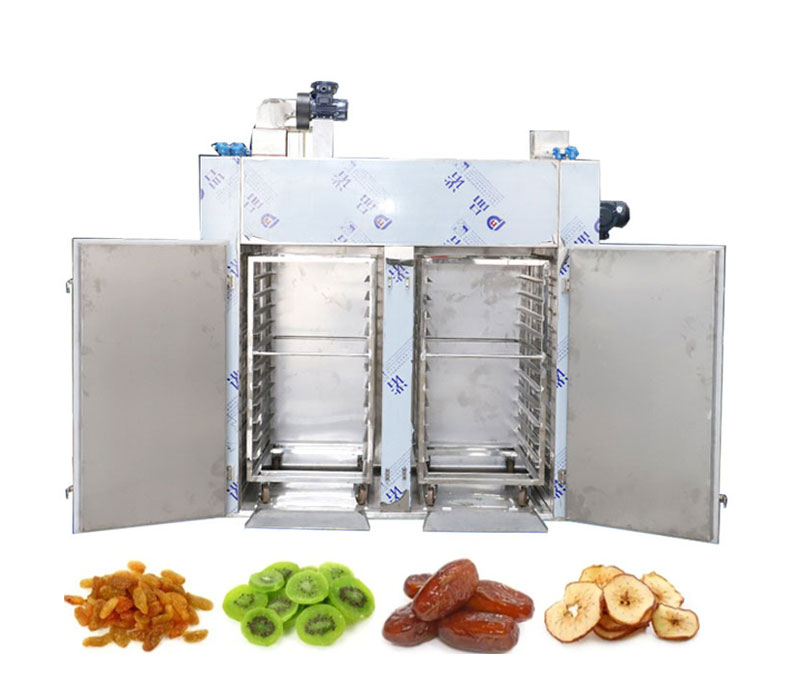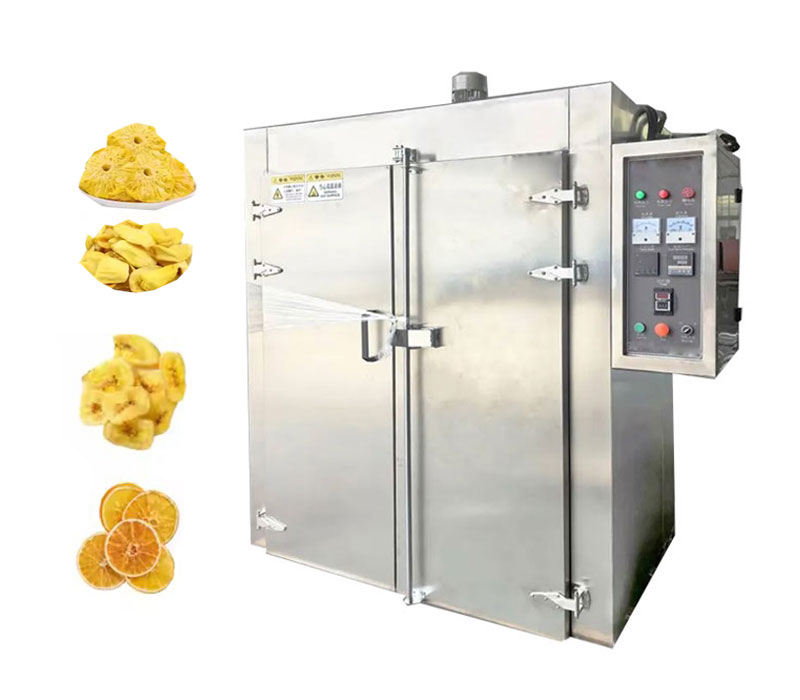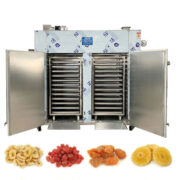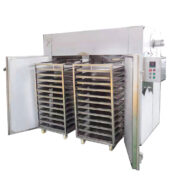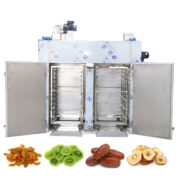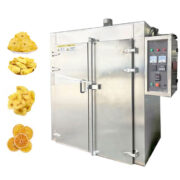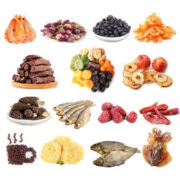Fruit Dehydrator Machine
Main Benefits
- Versatile use for various food products and materials.
- Environmentally friendly with no waste generation during drying.
- Preserves nutritional content of food during drying process.
- Quiet operation improves working environment and comfort.
- Adjustable convection for even temperature distribution throughout chamber.
- Automatic control optimizes temperature and humidity levels.
- Energy-efficient drying saves electricity and reduces operational costs.
- Fully automatic control reduces labor and effort.
- High air flow enhances hot air circulation efficiency.
- Maintains bright color and quality of finished products.
- Long service life and low operating costs enhance efficiency.
- Extends shelf life, preventing spoilage of dried goods.
- Smooth operation simplifies installation and maintenance tasks.
- Durable construction ensures long-lasting performance and reliability.
- Meets food hygiene requirements for safe processing.
Overview
Introducing our state-of-the-art fruit dehydrator machine, expertly engineered for efficient dehydration that preserves essential flavors and vibrant colors. This cutting-edge hot air circulation oven features a robust low-noise axial flow fan and an advanced automatic temperature control system, offering an optimal drying environment across a versatile temperature range of 50°C to 300°C. The innovative fan circulation method ensures uniform air distribution, maximizing moisture evaporation, while a seamless air recycling mechanism maintains consistent temperatures, even with fluctuations caused by door openings. With high thermal efficiency, this machine recycles hot air internally, leading to substantial energy savings during operation, making it an eco-friendly choice for both small and large-scale operations.
Dehydrating fruits offers a myriad of benefits, such as extended shelf life, preserved nutritional value, and enhanced flavors, while also providing convenience and reducing waste. Common fruits ideal for drying include apples, bananas, strawberries, peaches, pears, mangoes, apricots, and blueberries. This versatile fruit drying machine accommodates various heating sources—such as steam, electricity, hot oil, and gas—and features adjustable air distribution plates to ensure uniform drying across all trays. Designed for easy installation and maintenance, it is the perfect solution for producing high-quality dried fruits efficiently and sustainably.
Videos
Features
- Customization heating includes thermal oil, steam, hot water, electricity, and infrared.
- Control options feature touch screen and traditional panel for easy use.
- High energy efficiency maximizes hot air circulation within an insulated chamber.
- Adjustable plates optimize airflow for even drying and forced ventilation.
- Automatic control maintains ideal temperature without manual adjustments needed.
- Quick recovery ensures targeted temperatures are reached efficiently.
- Inlet features primary and medium efficiency filters for customized air quality.
- Intelligent thermostat self-tunes for precise temperature control during drying.
- Excellent insulation reduces energy consumption and operating costs significantly.
- User-friendly controls enable straightforward temperature and airflow setting.
- Air distributor ensures consistent hot air distribution for reliable drying.
- Various tray types let you process a range of wet materials.
- Eco-friendly design operates without harmful emissions, reducing pollution.
- Hygienic construction from SUS304 stainless steel allows for easy cleaning.
Specifications
| Model | Heating Way | Batch Capacity (Kg) | Tray Size (mm) | Tray No. | Trolley Size (mm) | Trolley (Set) | Machine Dimension L*W*H(mm) |
| FDM-10CT | Electric/Steam/Natural Gas/Thermal Oil | 120-160 | 600*800 | 24 | 1200*800*1800 | 1 | 2000* 900*1950 |
| FDM-20CT | Electric/Steam/Natural Gas/Thermal Oil | 240-288 | 600*800 | 48 | 1200*800*1800 | 2 | 3000*1200*2000 |
| FDM-30CT | Electric/Steam/Natural Gas/Thermal Oil | 480-576 | 600*800 | 96 | 1200*800*1800 | 4 | 3000*2200*2000 |
| FDM-40CT | Electric/Steam/Natural Gas/Thermal Oil | 720-864 | 600*800 | 144 | 1200*800*1800 | 6 | 4400* 2200*2600 |
| FDM-50CT | Electric/Steam/Natural Gas/Thermal Oil | 960-1152 | 600*800 | 192 | 1200*800*1800 | 8 | 5600* 2000*2600 |
Note:
Above parameters are for standard models, it can be customized according to customers requirements.
① Effective heating temperature 30-180℃.
② Tray size also can be 600*460, we can customize.
③ Machine material can be aluminum plate or stainless steel.
FAQ
What should I confirm before purchasing one fruit dehydrator machine?
Before purchasing one fruits dehydrator machine, it’s essential to confirm the following questions.
Heating Method: Determine the type of heating method that best suits your needs, such as electric, natural gas, coal, or steam, thermal oil .
Product Specifications: Identify the types of products you will be drying and their approximate sizes to ensure the dryer can accommodate them.
Weight and Output: Assess the product weight, including single weight and the desired hourly output to align with your production requirements.
Moisture Content: Understand the initial moisture content of your products before drying and establish the target moisture requirements after drying to ensure optimal performance.
By confirming these parameters, you can select the right dehydrator machine that meets your specific needs.
What are the primary uses of fruits dehydrator machine?
Fruits dehydrator machine are primarily used for drying a wide range of products to enhance their economic value and increase earnings. Key applications include:
Agricultural Products: Dehydrator machines are used for fruits (like jujube, lychee, and longan), vegetables (such as peppers and edible fungi), and grains (including rice and corn) to prolong shelf life and improve preservation.
Meat Products: Dehydrator machine help in drying various meats, including beef jerky and cured meats, which removes moisture and helps in preservation while extending their shelf life.
Seafood: Drying seafood such as fish, shrimp, and squid not only preserves these products but also enhances their flavor and texture.
Medicinal Materials: Drying Chinese medicinal herbs like honeysuckle, ginseng, and star anise is crucial for maintaining their potency and shelf life.
Dried Flowers & Forage: Flowers (like roses and chrysanthemums) and forage are dried to retain their properties for use in various applications.
Industrial Uses: Dryers are also employed in industrial applications for drying chemical products, sludge, paper products, and other materials.
Overall, the drying process helps in moisture evaporation, thereby ensuring preservation, preventing spoilage, and extending the usability of various products across different industries.
What are the precautions for dehydrating wolfberries with fruits dehydrator machine?
Spread the fresh wolfberries on a bamboo mat or bamboo sieve, place it in a drying room, and first dry it at 40-50℃ for 24-36 hours. Some fruits will shrink and wrinkle. Then raise the temperature to 50-55℃ and dry it for about 24 hours. The dryness ratio is about 25%.
The dehydrating process of wolfberry is not easy to turn over, and different temperatures need to be set at different times.
How to dehydrate longan fruits with a fruit dehydrator machine?
The key to longan dehydrating is to master the temperature and uniformity. The drying time is 20 hours, and the temperature is controlled at 65-70 degrees. The flat grid electric heating drying system does not need to be turned over, and the upper and lower parts will be uniform. The dehumidification starts 1 hour after the drying starts, and the drainage pipe is used for continuous drainage. After about 18 hours, the drainage is basically completed. It takes 2 hours to consolidate the drying. The finished product is a hard shell, the flesh is yellow-brown or reddish brown with oily luster, with fine wrinkles, the outer skin of the kernel is easy to fall off, and the kernel is pale white.
What is the process of dehydrating dates and what should be paid attention to?
a. The temperature is set at 45-50 degrees and the humidity is 50% in the early stage of drying. The temperature is gradually increased to evaporate a large amount of free water inside the jujube. At this time, the temperature is increased by 55 degrees and the humidity is reduced by 45%. Keep the indoor temperature from changing too much so that the evaporation of water can be continued.
b. Evaporation: To evaporate a large amount of free water inside the jujube, at this time, the fire must be increased to make the temperature in the drying room reach 68-70℃ within 8-12 hours, but never exceed 70℃. It must reach above 60℃ to facilitate the evaporation of a large amount of water, and pay attention to ventilation and dehumidification. Open the window to vent 5-10 times during each production shift. After ventilation and dehumidification, the air intake and exhaust ports must be closed to increase the indoor temperature rapidly, so as to continuously evaporate water. When wrinkles appear on the surface of the jujube, it means that the drying is normal. But pay attention to the fire should not be too large in the later stage, otherwise it is easy to burn or the jujube is unevenly dry.
c. Dehydrating: The total time for drying jujube is generally 15-20 hours (the drying time will be different for varieties with different fruit sizes and sugar content) per batch, the temperature is controlled between 55-70 degrees, and the dehumidification fan continuously dehumidifies, and finally the moisture content of the red jujube is reduced to about 15%
d. Cooling: The baked dates must be ventilated and heat-dissipated, and can be piled up after cooling. If the red dates just unloaded from the drying room are piled up in the warehouse, because the red dates themselves contain a lot of sugar, under the action of heat, the sugar is easy to ferment and deteriorate, and the original pectin in the dates will also decompose into pectin and pectin acid, which will inevitably make the dates a pile of mud, and will also change the sugar in the dates, and appear with sour filaments, so that the red dates will be damaged. Therefore, after baking, it must be thoroughly cooled before it can be stored.
How to make preserved fruit by fruits dehydrator machine?
Preserved fruit is made from fresh fruits through processing, candied, drying, and other procedures. Different fruit raw materials have different tastes after being made into preserved fruit. Preserved fruit is also called candied fruit in the north and cold fruit in Guangdong. Common ones include dried cherries, hawthorn slices, apple preserves, apricot preserves, peach preserves, plums, bayberries, fragrant preserved fruit, crabapple preserves, sour jujube cakes, fruit and vegetable cakes, blueberries, persimmon cakes, etc.
Adjust the temperature of the drying machine to 50℃ and the humidity to 65%, and dry for 12 hours. After drying for 12 hours, observe whether the outer skin is wrinkled enough, and push it out of the drying room for drying. The second time entering the drying room set the temperature to 45℃ and the humidity to 35%. After drying for 15 hours, push it out of the drying room to soften. When it reaches the softness, withdraw it and loosen the capsule. The third time drying, the temperature was 40 degrees, and dried for 10 hours. The drying is completed. The frosting is completed.
Note: Due to the difference in the size of fruits and the difference in temperature and humidity when drying indoors, the drying time will also vary.

